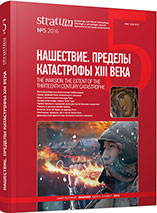Тверь в XIII-XIV вв. (К проблеме преемственности городской культуры в Северо-Восточной Руси после Батыева нашествия)
Tver in the 13th -15th Centuries (on continuity of urban culture in North-Eastern Russia after the invasion of Batu)
Author(s): Vladimir A. LapshinSubject(s): History, Archaeology, Economic history, Social history, Middle Ages, 13th to 14th Centuries
Published by: Издательский дом Stratum, Университет «Высшая антропологическая школа»
Keywords: North-Eastern Rus; Tver; 13th century; Mongol-Tatar invasion; Old Russian city; cultural continuity
Summary/Abstract: After the Mongol invasion of 1237—1240, Vladimir and other old towns entered a long period of decline. The population flowed out to the marginal areas sparsely populated before. The article is devoted to the identity development of one of the «young» centers of North-East Russia — Tver in 13th—14th centuries. Development of dendrochronological scale for Tver allows tracing in detail the fate of the city. After fires, so common in medieval Rus’, residents would immediately rebuild their city. After the fires associated with the seizure of the city by Tatar troops in 1238 and 1327, construction resumed only in 6—7 years. When finds are linked to narrow chronological periods, one can see the importance of the capital of one of the great North-Eastern Rus’ princedoms. This was a young center, in which urban culture was formed unevenly. The fashion of glass bracelets, together with doubtlessly close and varied links with Novgorod, reaches its peak a century later. Rustic decorations of “Kurgan type” continued to be popular for a very long time. Such decorations are habitually associated with the pre-Mongol period. Blacksmith’s work, and production of weapons and work instruments, on the contrary, completely conforms with advanced technological schemes, although the change in these instruments was more delayed. This seems to be the result of the constant negative influence of the Golden Horde yoke, which was felt here much more directly than in the Novgorod lands.
Journal: Stratum plus. Археология и культурная антропология
- Issue Year: 2016
- Issue No: 5
- Page Range: 117-124
- Page Count: 8
- Language: Russian
- Content File-PDF

